text: chris dorsett
becoming an artist in residence: |
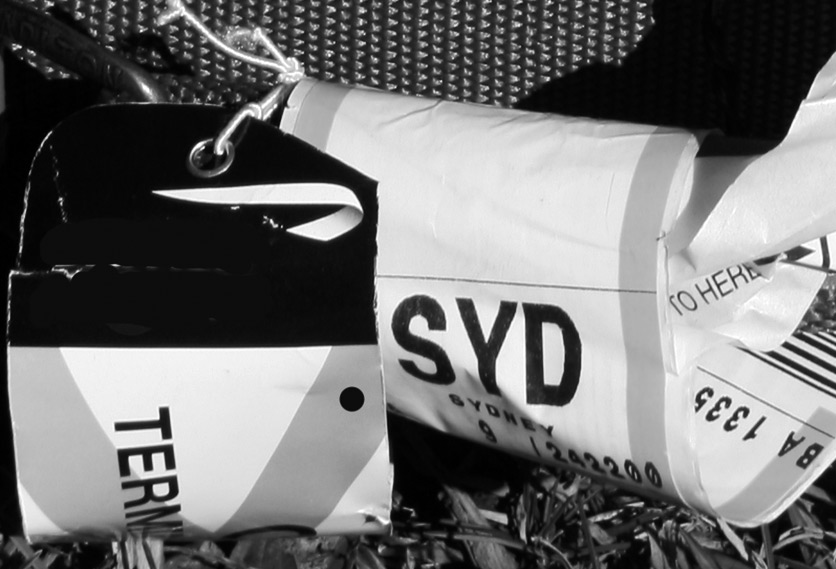 |
|
Being an artist-in-residence is not as straightforward as it seems. I listen to Christopher Jones talking about the four residency projects he has undertaken in the past three years. His descriptions are richly informed by the experience of imagining destinations, realising arrivals and then working towards a homecoming via the emotionally charged process of departure. To deliberately lift oneself out of the hard-won habits of practice in order to travel suggests to me an unresolved tension between the international mobility of contemporary art and the artist’s heart-felt need to stay put in a studio and work. What is really happening here? Something about Jones’ narratives advocate mobility as a creative condition, it is not just a matter of setting up a project in order to go somewhere else to do something new. His desire to keep on the move could be interestingly examined within the academic frame of mobilities – a field of theoretical research that has, over the past decade, persuaded many geographers to stop modelling human occupancy on sedentary states. The concept of mobilities requires us, as David Bissell argues in his writing on railway travel, to stop thinking of transport technologies as radical modifiers of stationary lives. Because ‘inhabiting’ has always been a matter of movement, the long interdependence of people and travel turns out to be an important category of knowledge, an area of interdisciplinary study that is as significant for arts practitioners as it is for social scientists. |
||
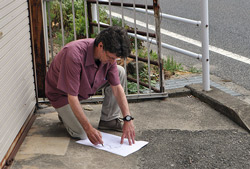 |
Jones tells me about the journeys involved in his residency projects. As he speaks I picture the continuous movement of creative people and their created objects, not just the physical motion of artists and artworks as they are taken from one place to another, but also the reiteration of creative production at one geographic location after another. Perhaps the rapid expansion of opportunities to become an artist-in-residence reflects a wider diffusion of ideas about the location of artistic practice (for example, the discourses associated with site-specificity or relational aesthetics). The interesting point is that the current spatial |
|
diffusion of art practice strikes us a such an obvious development – contemporary art seems to require all artists to be out and about within what Rosalind Krauss famously called an ‘expanded field’. Because this expulsion from the studio has been following its ‘post-lapsarian’ dynamic for more than thirty years, it is probably high time artist-researchers in universities made a start on aligning mobilities research with this established art world thinking. Furthermore, maybe the facilitators of residency programmes should pay particular attention to what Bissell says – the different types of vehicles that move us around the world are much more than mechanical disruptors of sedentary living. If Bissell thinks our understanding of travel is based on a false dichotomy between the motile and the quiescent, then it may also be true that the aspirational mobility promoted by arts organisations misrepresents the cloistered stability of studio-bound practices. It seems odd that the ambition to strengthen the scope that artists have to move around the world involves the curiously homely invitation to reside. As the title of this short essay suggests, the ambiguity at the heart of the term ‘artist-in-residence’ is the topic I want to explore in relation to the mobilities of an artist like Jones. |
||
When I myself think about residing I call to mind a landscape in which I did not grow up nor now live, in which I was neither blessed with stability nor imbued with stillness. The place in question is a stretch of modest English ‘fold’ country stretching between Oxfordshire and Warwickshire that I only learnt to fully inhabit when it became a place of return after periods of university teaching in Newcastle-Upon-Tyne. During these periods of repatriation I noticed, as I had not before, the countless tangled footpaths and bridle ways that measure out and weave together a gentle up-and-down |
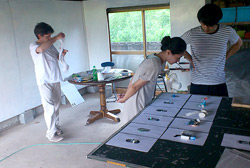 |
|
landscape which has been so plotted and pieced that the land mass itself is now almost completely a product of the plough. Everywhere has been neatly honed but the soil beneath your feet turns out to be not so tidy. The degraded spillage of modern farming has littered the earth with plastic shards amongst which, whilst walking by a freshly tilled field, one could easily find enough archaeological or fossil debris to fill several pockets. Thus to learn to reside in this countryside is a matter of knowingly moving back and forth on its ground-up past, on the micro-scale residue that scatters its history throughout both the landscape and the imagination. |
||
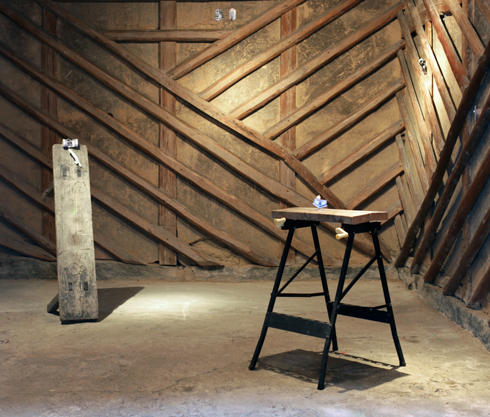 |
Such pastoral nearsightedness may sit oddly with my theme. Indeed, to speak of residing in this manner brings to mind the world-disclosing endurance of ‘dwelling’ which Martin Heidegger placed at the heart of human existence. This condition is analogous to, in the philosopher’s own words, a ‘clearing’ in which we have space to cultivate ‘access to the being that we ourselves are’. On the face of it Heidegger’s concept advocates a need to settle down, build permanent homesteads, and root ourselves in the land. But the journeys that Jones undertakes create room enough in which to dwell if, that is, one recognises the more nomadic dimensions of this idea. When an artist has travelled to some far-flung location even the everyday task of sweeping the studio floor fills the air with |
|
dust so strange that it smells like a different planet. For example, Jones has been resident artist in an historic Japanese rice store on the southern island of Kyushu that has been cleared of its agricultural contents in order to establish an empty space for artists to use. To work in this studio is to creatively negotiate a dusty past that is entirely foreign to an artist from Europe. Jones says that even the artworks he made there turned up like decorous visitors. They would only start to look like art, discretely, after settling into the space. As a result, we assume that his activities ‘there’ can only be different from his activities ‘here’ even though, in the end, the resulting artworks will be removed and brought back to his studio in England, a home space in which a short period of residence in Japan can only be, in the greater scheme of things, absorbed into the lengthier cycles of Jones’ commitment to his ongoing progress as an artist. |
||
Home for Jones is a converted Victorian chapel in rural Northumberland that is large enough to contain both domestic living space and a studio. To talk about carving out a place in the world is apt. It is a monumental dwelling, an architecturally-conceived structure that was raised on foundation stones which were fashioned by 19th century stonemasons to carry institutional inscriptions as far as possible into the future. Across the short distance between this building and the railway line that links the surrounding village to Newcastle, one can pace out in one’s imagination the exciting departures made from this chapel as Jones sets out to reside in other studios. Somewhere down the tracks – beyond national railways stations, international airports and transcontinental flights – he can go to work in Hill End, a deserted Australian gold-rush town where century-old corrugated iron houses are rusting into the ground. At Bundanon, another Australian residency on the banks of the Shoalhaven river, Jones uses one of the retreats for artists that the painter Arthur Boyd established on a run-down colonial homestead. To experiment with residing at these distant heritage sites, as my own intensely local perambulations along Oxfordshire footpaths suggests, is a matter of becoming intimate with the ground-up past beneath you, the accumulated and composite residue underfoot that offers immediate opportunities to understand the substance of a place. Thus, for a newly arrived artist-in-residence, the clearing in which Heidegger pictures him or her dwelling is as much a room-making action as a physical space. After all, at their point of inception, clearings have to be physically cleared, and artist’s studios actually swept clean, in order to initiate a state of productive dwelling.  |
||
It could be that the ‘clearing’ metaphor relies a little too much on the idea of securing a space beyond the safety of one’s usual frontiers or borders. The current media attention being given to Second World War ‘monuments’ officers offers a useful example. Robert Edsel’s books tell extraordinary stories about courageous experts from the arts being conscripted into the US Army to protect European cultural treasures as the Allies advanced through Italy and France. Amongst foreign ruins, amidst the bewildering territorial gains and losses of frontline fighting, their task was to track down and rescue endangered artworks. This act of emergency mobilization enforced, with great difficulty, cultural ‘clearings’ where military law held sway. |
||
Different times and contrasting mobilities make present-day frontier-crossing much less dangerous than those experienced by wartime military personnel. The discarded packaging or abandoned rubber bands located by Jones do not need to be rescued. If anything these salvaged objects are inconsequential and ephemeral. Here we should remember that Krauss built her argument in favour of the expanded field around the creative crisis that followed the failure of August Rodin’s major public commissions. This was not simply a turning point in the sculptors career, it was also a watershed in the history of European art. After 1898 Rodin no longer believed that his memorial to Balzac would find a permanent site where it belonged, in Paris. In Krauss’ account, from this key moment, the sculpture became a non-sedentary object that could be shipped off to exhibitions in galleries and museums anywhere in the world. The historic connection between a monumental statue and a significant civic location had been severed. Eventually, multiple versions of the Balzac figure would become ubiquitous representatives of this artist’s oeuvre in major art collections across the globe. This initiated new sculptural practices that, free of any obligation to what Krauss calls the logic of the monument, expanded to embrace the site-specific marking of locations made relevant by artistic convictions rather than civic history. Interestingly, the disillusioned Rodin also believed that Edward Steichan’s 1908 photograph of the Balzac statue, standing in his moonlit studio, captured the essence of his thinking as a sculptor. It is not just that this image shows a plaster version of the statue waiting forever to be sent to the foundry, but also that, in the mind of this maker of monumental bronzes, a photographic print could be substituted for the object itself. Out in the expanded field we would define this substitution as an unmonument, a site-less and itinerant form of sculptural expression.
In this sense, Jones’ use of photography returns us to the monument’s moment of crisis. For example, the lozenge-shaped recess that serves as the handle of the door into the Japanese rice store becomes a Kraussian site-marker if, as the artist moves back and forth, this curious device is not simply handled but also photographed. When the resulting image is folded and bent into a small sculptural assemblage the fleeting actions of arriving or departing receive much more than our passing attention. Once this piece is installed inside the rice store, the act of pushing or pulling the door is substituted for the enduring presence of a memorialising statue. 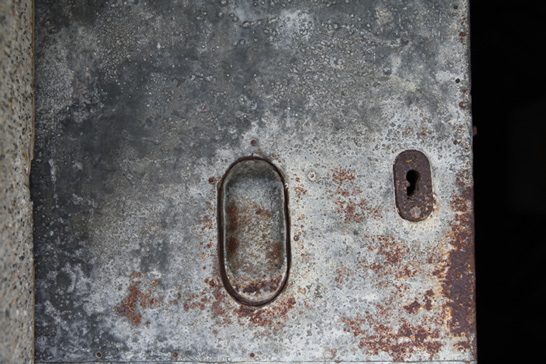  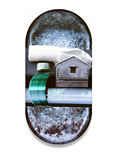 Thus we arrive at a formula in which the transportable character of Jones’ assemblages marks a very contemporary opposition to the cataleptic memorialisation of classical European Art. As Jones comes and goes from his residency studio he makes diminutive structures that propose alternatives to the size and weight of traditional monuments. Peter Mason, following Jean-Pierre Vernant, has made it clear that the gigantic Ancient Greek sculptures traditionally known as ‘colossi’ were associated with the ancestral dead, not towering gods. Thus it was a sense of deathly inertness that created the unheimlich monoliths which now force contemporary artists like Jones to work in a non-sedentary fashion – with small throwaway objects. Recently returned from residing in the Norwegian town of Drammen, Jones brings with him a photographic record of the site-marking activity that became the core concern of his work there. Also in his luggage are the tiny structures themselves. There they are in the photographs marking out an installation that Jones calls: Unmonumental: for the silo. After the business of creating a distant clearing, and then creatively residing in this space, I note that there follows an obligation to bring it all back home. Has it not always been the case that an odyssey prefigures a return.  I look at photographs of the little collages of Blu-Tack and torn boarding passes that Jones installed inside the old wood-pulp store that served as the residency studio and exhibition space. These are site-dependent unmonuments involving no feat of foundry production, nor any other technique of permanent memorialisation. Nevertheless, these works retain the powerful ability to mark a site. And what an extraordinary site it is. Jones describes the cylindrical studio-silo as a ‘vestige’ of Drammen’s once-famous paper industry. Thus the clearing that has been marked out by the residency is itself vestigial, like a piece of archaeological debris picked up in a field. Now that Jones is home again this essay is a way of asking him if he thought about his return whilst he was in Norway. As in the Odyssey, written at a time when European culture followed the logic of the monument, mobility has long created conflicting tensions between the state of exile and the need to come home. Odysseus had to choose. Jones doesn’t – if his goal is to remain mobile then becoming an artist-in-residence could never be as residential as the name implies. |
||